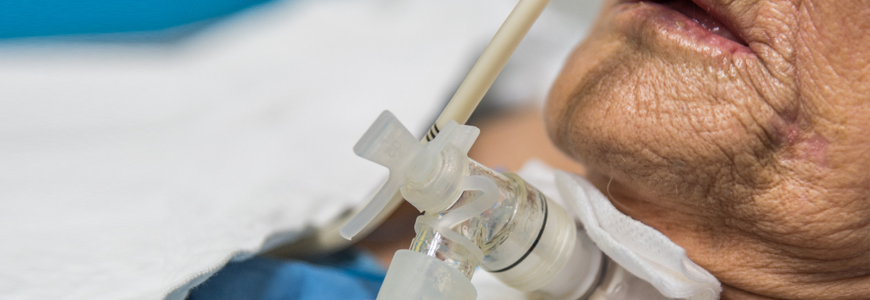Treatment innovations for patients with COVID-19 introduced by Duke Pulmonary, Allergy, and Critical Care Medicine Division specialists during the initial viral surge in spring 2020 have evolved into standard-of-care therapies.
After encountering some of the first patients admitted with high-risk presentations, pulmonologists in Duke medical ICUs initiated the use of tracheostomies to provide a safer, more comfortable airway for the patients on ventilators. The tracheostomies also helped wean the patients off ventilators, says Kamran Mahmood, MD, MPH, a Duke interventional pulmonologist who directed the tracheostomy implementation.
Another novel therapy was the use of the bronchoalveolar lavage (BAL) obtained using bronchoscopy as a diagnostic tool to confirm COVID-19 infection. The Duke team is contributing to several national studies and guidelines assessing the impact and practice of both procedures in the care of COVID-19 patients.
Duke pulmonologists were among the first to develop innovative protocols for management of patients with prolonged respiratory failure and acute respiratory distress syndrome due to COVID-19. The pulmonologists worked with a multidisciplinary team of infectious disease specialists, thoracic surgeons, trauma surgeons, otolaryngologists, anesthesiologists, respiratory therapists and nurses.
Mahmood says tracheostomies are essential to manage patients with respiratory failure who require prolonged mechanical ventilation. But tracheostomies generate aerosols that present infection transmission risks to health care providers.
“We developed a multi-disciplinary protocol to perform the tracheostomy within three weeks of mechanical ventilation of COVID-19 patients,” says Mahmood. “This has led to decrease in the need for sedation in our patients, quicker weaning off the ventilator and shorter ICU and hospital length of stay. We also incorporated safety measures to reduce the risk of transmission of infection to the health care providers during and after tracheostomy.”
Treating the largest N.C. populations with COVID-19
When the protocol was being incorporated, Duke clinicians were treating one of the largest North Carolina patient populations with COVID-19, many of whom required ventilators or extracorporeal membrane oxygenation (ECMO) as a result of respiratory failure. The challenges of treating these patients were made more complex by the need to protect patients and staff.
“Our procedures require more time,” Mahmood says. “The donning and doffing of personal protective equipment and other safety measures are critical for keeping our teams safe. We found ourselves busier than before COVID because of the safety and preventive steps we were undertaking for the procedures.”
Duke team found a high concordance in the yield of BAL with nasopharyngeal swabs in diagnosis of COVID-19. Therefore, BAL use is now limited to select patients with high clinical suspicion of COVID-19 for whom nasopharyngeal swabs are repeatedly negative.
Another challenge is taking care of the patients with lung and metastatic cancers, complex airway disorders and pleural disease during the COVID-19 pandemic. “We implemented policies to ensure that not only all the bronchoscopies and pleural procedures are done safely, but any delays in the care of our patients are avoided.” Mahmood adds.

